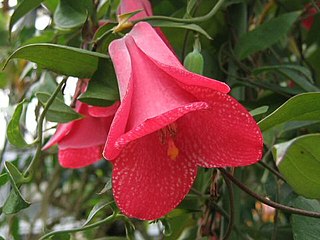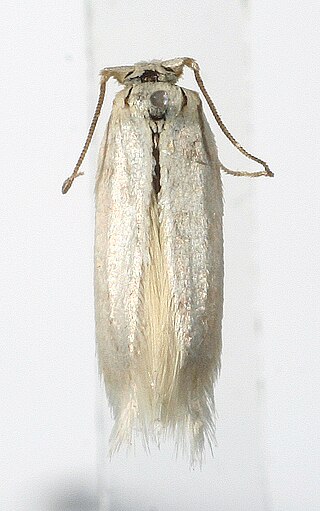Related Research Articles

Campanulales is a valid botanic name for a plant order. It was used in the Cronquist system as an order within the subclass Asteridae in the class Magnoliopsida flowering plants. As then circumscribed it included the families:
In biology, an identification key, taxonomic key, or biological key is a printed or computer-aided device that aids the identification of biological entities, such as plants, animals, fossils, microorganisms, and pollen grains. Identification keys are also used in many other scientific and technical fields to identify various kinds of entities, such as diseases, soil types, minerals, or archaeological and anthropological artifacts.

The Potamogetonaceae, commonly referred to as the pondweed family, is an aquatic family of monocotyledonous flowering plants. The roughly 110 known species are divided over six genera. The largest genus in the family by far is Potamogeton, which contains about 100 species.

Zosteraceae is a family of marine perennial flowering plants found in temperate and subtropical coastal waters, with the highest diversity located around Korea and Japan. Most seagrasses complete their entire life cycle under water, having filamentous pollen especially adapted to dispersion in an aquatic environment and ribbon-like leaves that lack stomata. Seagrasses are herbaceous and have prominent creeping rhizomes. A distinctive characteristic of the family is the presence of characteristic retinacules, which are present in all species except members of Zostera subgenus Zostera.
DELTA is a data format used in taxonomy for recording descriptions of living things. It is designed for computer processing, allowing the generation of identification keys, diagnosis, etc.

Eupomatia is a genus of three species of plants in the ancient family Eupomatiaceae, and is the sole genus in the family. Eupomatiaceae is recognised by most taxonomists and classified in the plant order Magnoliales. The three described species are shrubs or small trees, native to the rainforests and humid eucalypt forests of eastern Australia and New Guinea. The type species Eupomatia laurina was described in 1814 by Robert Brown.

Ancistrocladus is a genus of woody lianas in the monotypic family Ancistrocladaceae. The branches climb by twining other stems or by scrambling with hooked tips. They are found in the tropics of the Old World.
Physena is the sole genus of the flowering plant family Physenaceae. It contains two species of shrubs and small trees which are endemic to Madagascar. The APG II system, of 2003, does recognize this family and assigns it to the order Caryophyllales in the clade core eudicots.

Philesiaceae is a family of flowering plants, including two genera, each with a single species. The members of the family are woody shrubs or vines endemic to southern Chile.

Flagellaria is the sole genus in the flowering plant family Flagellariaceae with only five species. The family has historically been recognized by few taxonomists. The APG II system, of 2003, does recognize such a family, and assigns it to the order Poales in the clade commelinids, in the monocots.

Rhabdodendron is a genus comprising two or three species of tropical South American trees.

Opostegidae or "white eyecap moths" is a family of insects in the order Lepidoptera that is characterised by particularly large eyecaps over the compound eyes. Opostegidae are most diverse in the New World tropics.

Phyllonoma is a genus consisting of 4 species of trees and shrubs. Phyllonoma is the sole genus in the family Phyllonomaceae. Phyllonoma species are native to South and Central America.
Automated species identification is a method of making the expertise of taxonomists available to ecologists, parataxonomists and others via digital technology and artificial intelligence. Today, most automated identification systems rely on images depicting the species for the identification. Based on precisely identified images of a species, a classifier is trained. Once exposed to a sufficient amount of training data, this classifier can then identify the trained species on previously unseen images.
A branching identification key within taxonomy, is a presentation form of a single-access key where the structure of the decision tree is displayed graphically as a branching structure, involving lines between items. Depending on the number of branches at a single point, a branching key may be dichotomous or polytomous.
In phylogenetics, a single-access key is an identification key where the sequence and structure of identification steps is fixed by the author of the key. At each point in the decision process, multiple alternatives are offered, each leading to a result or a further choice. The alternatives are commonly called "leads", and the set of leads at a given point a "couplet".
Psychometric software is software that is used for psychometric analysis of data from tests, questionnaires, or inventories reflecting latent psychoeducational variables. While some psychometric analyses can be performed with standard statistical software like SPSS, most analyses require specialized tools.
In biology, determination is the process of matching a specimen of an organism to a known taxon, for example identifying a plant. The term is also used in cellular biology, where it means the act of the differentiation of stem cells becoming fixed. Various methods are used, for example single or multi-access identification keys.
Australian online fauna & flora databases: Both the Commonwealth of Australia and its various states maintain a number of online databases which encompass both native and naturalised fauna and flora. Some are taxonomic. Some are descriptive. Some are both. Some indicate threatened or nuisance species. The list below is incomplete.
Australian Tropical Rainforest Plants, also known as RFK, is an identification key giving details—including images, taxonomy, descriptions, range, habitat, and other information—of almost all species of flowering plants found in tropical rainforests of Australia, with the exception of most orchids which are treated in a separate key called Australian Tropical Rainforest Orchids. A key for ferns is under development. RFK is a project initiated by the Australian botanist Bernie Hyland.
References
- Krimmel, Erica. "Taxonomic Keys". collectionseducation.org. Retrieved 2024-01-12.